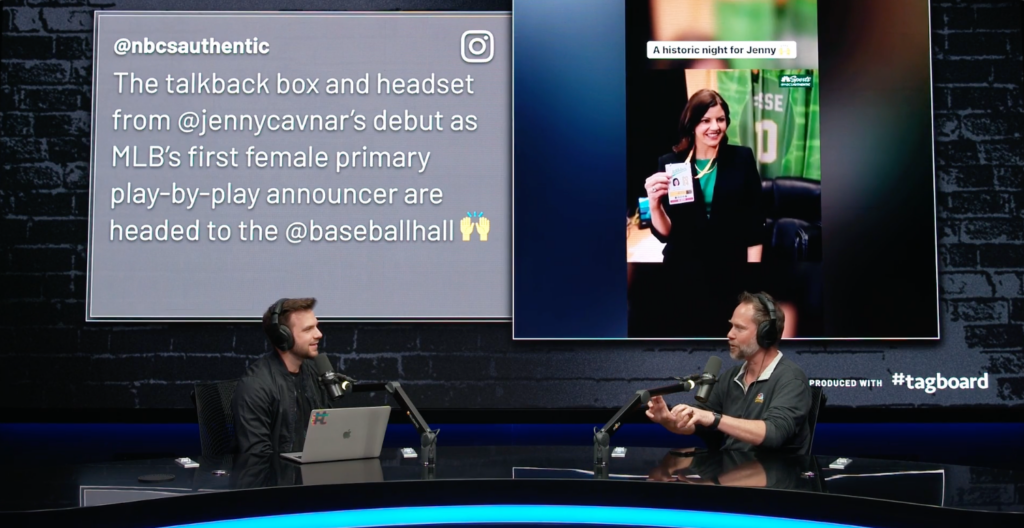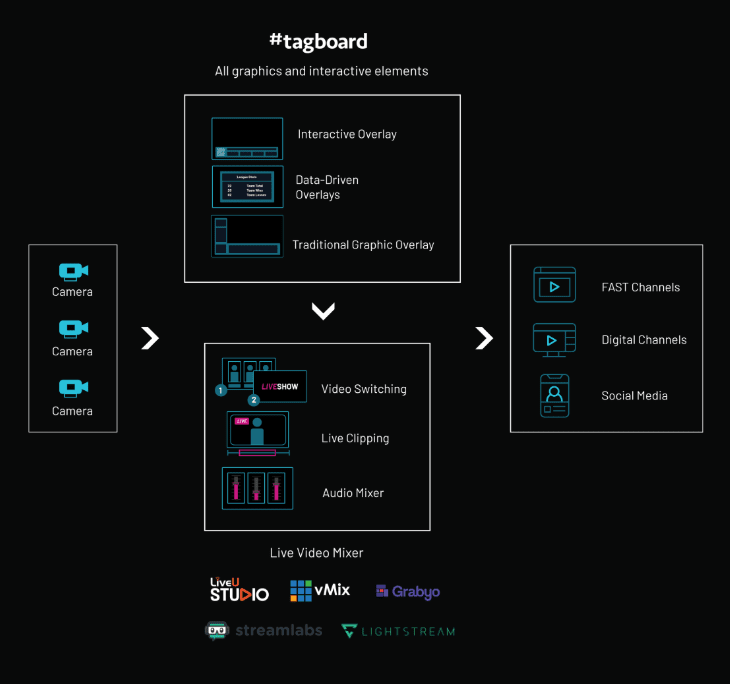
In 1979, The Buggles released their iconic hit “Video Killed the Radio Star,” an anthem about technological disruption and the inevitable march of progress. The song’s themes resonate loudly today, as the rise of video-first podcasts—or vodcasts—reshape the landscape of digital content creation. Just as music videos transformed the way audiences experienced songs, vodcasts are revolutionizing how audiences engage with podcasts.
The transition from audio to visual isn’t just an upgrade; it’s a paradigm shift. A video-first mindset is no longer optional for podcasters aiming to thrive in today’s content-saturated world, it’s a must. In this blog, we’ll explore why this evolution is happening, provide a guide on how to embrace it, and highlight the creators who are already leading the charge as we usher in the year of the vodcast
Why pivot your podcast to a vodcast?
In July 2024, YouTube achieved a groundbreaking milestone, claiming over 10% of daily time spent viewing on TV in the United States—a first for any streaming platform tracked by Nielsen. To put this in perspective globally, a YouTube blog revealed that viewers spend a staggering 1 billion hours streaming YouTube content on their TVs daily. Narrowing the focus to vodcasts, YouTube also reported that 400 million hours of podcasts are watched on TVs each month. The audience is clearly there, and video provides an unparalleled opportunity to connect with and grow your audience.
If YouTube’s numbers aren’t convincing enough, consider how leaders in the podcasting industry are adapting. Spotify, recognizing that many of its top-performing podcasts were posting video versions on YouTube and drawing users away from its platform, announced a new “Partner Program” in November. Taking a cue from YouTube’s monetization model, Spotify now compensates creators based on performance and engagement metrics. While YouTube remains the dominant force, platforms like TikTok, X (formerly Twitter), and Instagram are all powerful distribution channels for video podcasts, drawing massive audiences and attention.
How do you make your podcast a vodcast?
Transforming a podcast into a vodcast has never been more accessible. With just a few additions to your existing tech stack, you can start grabbing a piece of that ‘Partner Program’ pie and expanding your reach across video platforms.
The first step is deciding how you’ll produce your video podcast: live, live-to-tape (recorded with minimal post-production), or fully edited in post-production. Creators finding the most success are going fully live, as it’s the best route for growing a community. Live production enables real-time audience engagement through the chat and other interactive elements, making your content dynamic and immediately relevant.
Next, evaluate your existing tech stack. If you’re already producing a podcast, you likely have all the audio equipment you need. Adding video is simpler than you might think: invest in a quality camera, a live video mixer to manage multiple video sources, and tools for live switching and distribution across digital platforms.
The final piece of the puzzle takes your vodcast from looking like a basic Zoom call to resembling a high-budget, polished production: on-screen graphics. A cloud-based graphics system can achieve this with minimal resources, allowing even small teams—or a single operator—to produce professional-grade content. In addition to traditional graphics, systems like Tagboard enable interactive segments by introducing user-generated content, real-time comments, live polls, and dynamic data integrations for live sports. These elements elevate your vodcast, ensuring it stands out in an increasingly competitive landscape.
Here is a look at a lightweight, yet powerful and robust, production architecture:

Who can you look toward for guidance?
While there are already several early adopters demonstrating a winning formula for vodcasts, it’s important to emphasize that it’s not too late for newcomers to join the game. Success in this space is still highly attainable for those willing to adapt and innovate. One standout example is The Volume and its show Nightcap, co-hosted by Shannon Sharpe and Chad Ochocinco.
Nightcap with Unc & Ocho
The team at The Volume are striking while the iron is hot. By going live immediately after major sports events, they’ve become the go-to destination for instant reactions and post-game discussions. For instance, when Sunday Night Football wraps up, more than a quarter of a million viewers flock to YouTube to join Shannon and Ocho. The show leverages live viewer reactions, real-time player performance data, and creates multiple clippable moments that are seamlessly shared across all their channels. The late night destination for sports talk has generated a ton of buzz and has quickly become a formula we’ll be seeing others look to replicate in 2025.
The Jim Rome Show
Another show that generated a ton of buzz in 2024 was The Jim Rome Show. A staple on radio for several decades, Rome pivoted to video-first and digital-first, streaming daily on X.
In an effort to adapt to the evolving media landscape and reach a broader audience, Jim Rome has fully embraced video and digital streaming. His loyal fanbase, known as the Clones, has always been a cornerstone of the show, but the transition to X has taken audience interactivity to a new level. A key ingredient to the show’s success is its use of social content as B-roll, incorporating breaking news, player soundbites, and other relevant clips to enhance the visual storytelling. With daily viewership on X consistently nearing or exceeding the one-million mark, Rome has cemented his presence in the digital space. Beyond social platforms, the show also streams on FAST Channels, further expanding its reach and influence.
The Edge with Micah Parsons (Bleacher Report)
There are plenty of early adopters to point to, but to avoid going too long we’ll highlight just one more, and that is the team at Bleacher Report. They are producing 100’s of live shows every month with lean teams, and their vodcast content is driving huge results.
Micah Parsons’ show, The Edge, is a prime example of how video can elevate what might have historically been an audio-only podcast. With the Bleacher Report team behind it, the show allows Parsons to react to league news and share personal insights directly from the comfort of his home. The production incorporates traditional graphics, social media content, and a streamlined format that can be scaled effectively. Clips from the show often go viral, standing out on timelines thanks to their dynamic and visually engaging presentation—far more impactful than audio clips paired with a static graphic.
The success of early adopters like The Volume, the Jim Rome Show, and Bleacher Report illustrates that incorporating video into your podcast not only enhances the audience experience but also sets the stage for scalable, sustainable growth. In a world where attention spans are short and visual content reigns supreme, transitioning to vodcasts ensures your content remains relevant and competitive. It’s time to embrace the visual storytelling revolution—because just as video once redefined music, it’s now reshaping the podcasting landscape. The future of content isn’t just heard; it’s seen.
